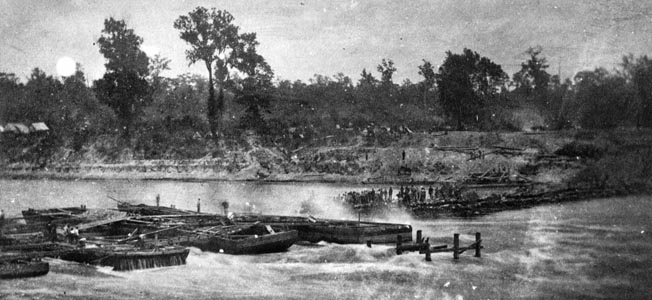April 1864
By Phil Kohn
Phil Kohn can be reached at USCW160@yahoo.com
On April 3, 1864, Union Maj. Gen. Frederick Steele, with 8,500 troops en route to join Maj. Gen. Nathaniel Banks’s Red River force at Shreveport, Louisiana, is attacked by Confederates at Okalona, Arkansas. Steele’s force manages to battle its way through.
In Virginia, the Army of the Potomac gets a new cavalry commander — Maj. Gen. Philip Sheridan. In Washington, D.C., the House of Representatives on April 4 passes a resolution stating that the United States will not tolerate establishment of a monarchy in Mexico. The legislators are concerned about French interest and activities in Mexico and their repercussions for Texas. (One of the motives for launching the Red River Campaign, in fact, is to ensure that the U.S. — and not the Confederacy — controls Texas and keeps the French out.) The House resolution is a bit late, however, as a monarchy in Mexico had already been decreed by the French, who invaded Mexico in 1862 to force the collection of unrepaid loans made to parties in the Mexican Civil War of 1858-1861. (Great Britain and Spain had originally partnered with France in the invasion, also to collect unrepaid loans. The two dropped out when they realized France had designs on also taking over the country rather than just collecting its debt.)
Lt. Gen. Richard Taylor on April 5 groups some 16,000 Confederates around Mansfield, Louisiana, intent on stopping Banks and Porter’s Red River offensive heading towards Shreveport, some 39 miles to the north.
In Louisiana, a constitutional convention meets at New Orleans on April 6 and adopts a new state constitution that abolishes slavery.
On April 7, Lt. Gen. James Longstreet is ordered to bring his army corps northward to Virginia to rejoin Robert E. Lee’s Army of Northern Virginia. Longstreet and his men had been in Tennessee since September 1863 and have participated in the actions at Chickamauga, Chattanooga and Knoxville.
By a vote of 38-6, the U.S. Senate on April 8 passes the 13th Amendment, abolishing slavery in the United States and all territory controlled by the Union Army. On the same day, in Louisiana, Maj. Gen. Nathaniel Banks, leading 12,000 troops along a narrow road several miles west of the Red River (and away from the protection of his accompanying fleet), is struck by 9,000 of Lt. Gen. Richard Taylor’s Confederates at Sabine Crossroads, south of Mansfield. Lacking room to maneuver, the Union force suffers 2,235 killed, wounded and captured; Confederate casualties number about 1,000.
The next day, April 9, the forces of Banks and Taylor meet again, at Pleasant Hill, Louisiana. Although the fighting essentially ends in a draw, Banks decides to withdraw to the Red River. Elsewhere, Union Lt. Gen. Ulysses Grant issues campaign orders for “a great move” — a Union offensive on all fronts set to start on May 4.
In Louisiana on April 10, Adm. David Porter gets word of Maj. Gen. Banks’s reversal and orders his fleet to reverse course and head back down the Red River. On the way to rendezvous with Banks at Alexandria, Porter’s fleet, hampered by very low water levels in the river, is ambushed at Blair’s Landing, Louisiana, and suffers some damage. In Arkansas, Maj. Gen. Frederick Steele’s force — still trying to make its way to join Banks’s troops on the Red River — is hit again at Prairie d’Ane, Arkansas, and pinned down for four days. In western Tennessee, Gen. Nathan Bedford Forrest launches another raid, this time splitting his force. One body of men heads north to once again attack Columbus and Paducah, Kentucky. Forrest leads another 1,500 troopers westward toward the Mississippi River. In Europe, Archduke Maximilian of Austria — urged by Mexican monarchists and swayed by the results of a “favorable plebiscite” by residents in the areas of Mexico under French control — agrees to accept the crown of Emperor of Mexico. Maximilian I and his wife, Princess Charlotte of Belgium (Empress Carlota), depart immediately for their new realm, a puppet regime of Emperor Napoleon III of France. Their reign will be tumultuous and tenuous, however, as the French presence is strongly resisted by Mexican republicans under ousted former president Benito Juárez.
Maj. Gen. Banks’s force, retreating southward, is attacked on April 11 by Confederate cavalry at Grand Ecore, Louisiana. At the same time, Adm. Porter’s accompanying flotilla of transports and gunboats are facing the problem of ever-lower water levels in the river. In addition, they are harassed by rifle fire and shelling from Confederate shore batteries.
On April 12, Maj. Gen. Banks and his Federals reach Natchitoches, Louisiana, where they spend the next week regrouping. In Tennessee, Maj. Gen. Nathan Bedford Forrest arrives at Union-held Fort Pillow, on the Mississippi River, with a force of 1,500 and demands surrender. The commander of the fort, defended by 557 soldiers, 262 of whom are African American, refuses. The Southerners attack and quickly overwhelm the position. Union casualties total 231 killed and 100 wounded; for the Confederates: 41 killed and 86 wounded. Controversy soon erupts over the fact that of 226 prisoners taken, only 58 are black. Union authorities claim that the fort surrendered almost immediately upon attack and that its soldiers — especially blacks — were massacred after surrendering. Southerners maintain that Federal losses occurred because the Union soldiers refused to give up and continued trying to fight their way out. Accusations, disputes and repercussions over this controversial incident will reverberate for years.
In Knoxville on April 15, former U.S. Senator Andrew Johnson, now military governor of the new pro-Union government of Tennessee, makes a speech in support of the emancipation of slaves.
On April 17, Lt. Gen. U.S. Grant complains that prisoner exchanges between the Union and the Confederacy have not been balanced equally. He states that in any future prisoner swaps “no distinction whatever will be made in the exchange between white and colored prisoners.” The last statement is a dealbreaker for the South. Confederate President Jefferson Davis will later respond by reiterating his oft-made statement rega
rding black Federal prisoners: “Captured slaves should be returned to their masters on proof and payment of charges.” The result is that no further prisoner exchanges will be made between the two sides, putting pressure on Confederate manpower. At the time, the U.S. is holding 146,634 Confederate soldiers as prisoners. Grant is criticized by both sides for his stance.
Maj. Gen. Frederick Steele’s Union force, still trying to move southward to rendezvous with Banks at Shreveport (and not knowing Banks has turned back), is attacked on April 18 at Camden, Arkansas. Fending off the attack, Steele cancels his offensive and orders a return to Little Rock. Confederate Gen. Pierre G.T. Beauregard moves from Charleston, South Carolina, to his new assignment: Commander of the Department of North Carolina and Southern Virginia. His orders: to defend Richmond, southern Virginia and northern North Carolina from a threatened invasion from the coast, led by Union Maj. Gen. Benjamin Butler.
In Louisiana on April 19 Maj. Gen. Banks and Adm. Porter decide to cancel the Red River Campaign and return to the Mississippi River. Back east, the ironclad ram CSS Albemarle, steaming down the Roanoke River, scatters the defensive Union flotilla at Plymouth, North Carolina. The next day, Brig. Gen. Robert F. Hoke leads 10,000 Confederate troops against the town, forcing the surrender of about 2,800 Federals and capturing plentiful supplies. Because there will be no more prisoner exchanges, all the Union prisoners are sent to Camp Sumter, near Andersonville, in southern Georgia.
On April 22, following an Act of Congress, the words “In God We Trust” begin to be stamped on all U.S. coins.
Finally reaching Alexandria, Louisiana, on April 25, Banks and Porter face a new problem: The level of the Red River has dropped so low that the Federal ships cannot get past the rapids below the town. Porter worries the fleet will be lost. In Arkansas, Confederates continue the pursuit of Maj. Gen. Frederick Steele’s retreating Federals and engage them at Mark’s Mill, on April 25.
After the fall of Plymouth, North Carolina, and the capture of its Federal garrison, Lt. Gen. Grant on April 26 orders the Union force at Washington, North Carolina, about 28 miles southwest of Plymouth, to withdraw. On the Red River, water levels have dropped to a depth of three feet in places (most of the Union vessels require at least seven feet of water). Lt. Col. Joseph Bailey of the 4th Wisconsin Cavalry, a civil engineer by training, makes a bold proposal to save the flotilla: Build a series of temporary dams and once a sufficient depth of water is collected, chute gates will be opened to let the vessels through and pass over the rapids on the resulting wave of water. In the meantime, Union vessels, constantly harassed by the Confederates, are being lost. The ironclad USS Eastport runs aground several times and is finally blown up by its crew. The gunboat USS Cricket is hit by 19 artillery shells, killing 31 of its 50-man crew. Two Federal pumpboats are destroyed, one of them, USS Champion 3, exploding from a direct artillery hit to its boiler, killing 200 crewmen.
On April 28, Maj. Gen. William T. Sherman, now in charge of all Union troops between the Appalachian Mountains and the Mississippi River, moves his headquarters from Nashville, Tennessee, to Chattanooga to take personal charge of a planned attack on the Confederate industrial hub of Atlanta. His opponent: Gen. Joseph Johnston, with 55,000 troops and 158 guns.
At Alexandria, Louisiana, Maj. Gen. Banks on April 30 acts upon the idea posited by Lt. Col. Joseph Bailey to save the Union fleet: building a series of temporary dams to raise the river’s water level, then releasing the water to let the ships ride over the rapids “on the wave.” Adm. Porter agrees that the plan may work, and Banks orders construction to begin on “Bailey’s Dams.” Still stalking Maj. Gen. Frederick Steele’s Union troops retreating towards Little Rock, Confederates attack again at Jenkin’s Ferry, Arkansas. In North Carolina, Brig. Gen. Robert Hoke’s Confederates capture Washington, about 28 miles southwest of Plymouth. The town had already been abandoned by its Union garrison. In Richmond, Virginia, five-year-old Joe Davis dies in a fall from a high veranda while playing at the Confederate White House. Now, both presidents — Lincoln and Davis — have lost sons while serving as their nation’s chief executive (11-year-old Willie Lincoln died — likely of typhoid — in February 1862).








